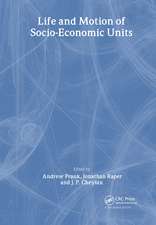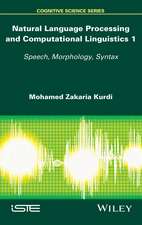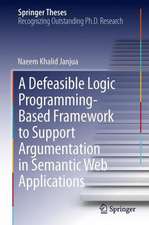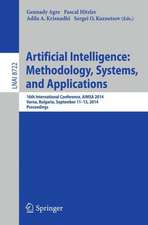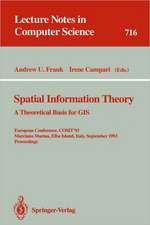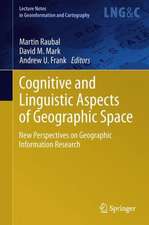Theories and Methods of Spatio-Temporal Reasoning in Geographic Space: International Conference GIS - From Space to Territory: Theories and Methods of Spatio-Temporal Reasoning, Pisa, Italy, September 21-23, 1992. Proceedings: Lecture Notes in Computer Science, cartea 639
Editat de Andrew U. Frank, Irene Campari, Ubaldo Formentinien Limba Engleză Paperback – 9 sep 1992
Din seria Lecture Notes in Computer Science
- 20%
 Preț: 1061.55 lei
Preț: 1061.55 lei - 20%
 Preț: 307.71 lei
Preț: 307.71 lei - 20%
 Preț: 438.69 lei
Preț: 438.69 lei - 20%
 Preț: 579.30 lei
Preț: 579.30 lei -
 Preț: 410.88 lei
Preț: 410.88 lei - 17%
 Preț: 427.22 lei
Preț: 427.22 lei - 20%
 Preț: 596.46 lei
Preț: 596.46 lei - 15%
 Preț: 448.04 lei
Preț: 448.04 lei - 20%
 Preț: 353.50 lei
Preț: 353.50 lei -
 Preț: 389.49 lei
Preț: 389.49 lei - 20%
 Preț: 309.90 lei
Preț: 309.90 lei - 20%
 Preț: 645.28 lei
Preț: 645.28 lei - 20%
 Preț: 763.23 lei
Preț: 763.23 lei - 15%
 Preț: 580.46 lei
Preț: 580.46 lei - 20%
 Preț: 310.28 lei
Preț: 310.28 lei - 20%
 Preț: 655.02 lei
Preț: 655.02 lei - 20%
 Preț: 1183.14 lei
Preț: 1183.14 lei - 20%
 Preț: 340.32 lei
Preț: 340.32 lei -
 Preț: 449.57 lei
Preț: 449.57 lei - 20%
 Preț: 591.51 lei
Preț: 591.51 lei - 18%
 Preț: 938.83 lei
Preț: 938.83 lei - 20%
 Preț: 337.00 lei
Preț: 337.00 lei - 20%
 Preț: 649.50 lei
Preț: 649.50 lei - 20%
 Preț: 607.40 lei
Preț: 607.40 lei - 20%
 Preț: 1414.79 lei
Preț: 1414.79 lei - 20%
 Preț: 1024.44 lei
Preț: 1024.44 lei - 20%
 Preț: 583.40 lei
Preț: 583.40 lei - 20%
 Preț: 453.32 lei
Preț: 453.32 lei - 20%
 Preț: 575.49 lei
Preț: 575.49 lei - 20%
 Preț: 1075.26 lei
Preț: 1075.26 lei - 20%
 Preț: 585.88 lei
Preț: 585.88 lei - 20%
 Preț: 825.93 lei
Preț: 825.93 lei - 17%
 Preț: 360.20 lei
Preț: 360.20 lei - 20%
 Preț: 763.23 lei
Preț: 763.23 lei - 20%
 Preț: 340.32 lei
Preț: 340.32 lei - 20%
 Preț: 504.58 lei
Preț: 504.58 lei - 20%
 Preț: 369.13 lei
Preț: 369.13 lei - 20%
 Preț: 580.93 lei
Preț: 580.93 lei - 20%
 Preț: 343.62 lei
Preț: 343.62 lei - 20%
 Preț: 350.21 lei
Preț: 350.21 lei - 20%
 Preț: 583.40 lei
Preț: 583.40 lei - 20%
 Preț: 583.40 lei
Preț: 583.40 lei - 15%
 Preț: 438.59 lei
Preț: 438.59 lei - 20%
 Preț: 341.95 lei
Preț: 341.95 lei - 20%
 Preț: 238.01 lei
Preț: 238.01 lei - 20%
 Preț: 538.30 lei
Preț: 538.30 lei
Preț: 339.99 lei
Preț vechi: 424.99 lei
-20% Nou
Puncte Express: 510
Preț estimativ în valută:
65.07€ • 67.68$ • 53.72£
65.07€ • 67.68$ • 53.72£
Carte tipărită la comandă
Livrare economică 14-28 aprilie
Preluare comenzi: 021 569.72.76
Specificații
ISBN-13: 9783540559665
ISBN-10: 3540559663
Pagini: 452
Ilustrații: XIII, 439 p.
Dimensiuni: 155 x 235 x 24 mm
Greutate: 0.63 kg
Ediția:1992
Editura: Springer Berlin, Heidelberg
Colecția Springer
Seria Lecture Notes in Computer Science
Locul publicării:Berlin, Heidelberg, Germany
ISBN-10: 3540559663
Pagini: 452
Ilustrații: XIII, 439 p.
Dimensiuni: 155 x 235 x 24 mm
Greutate: 0.63 kg
Ediția:1992
Editura: Springer Berlin, Heidelberg
Colecția Springer
Seria Lecture Notes in Computer Science
Locul publicării:Berlin, Heidelberg, Germany
Public țintă
ResearchCuprins
Do people understand spatial concepts: The case of first-order primitives.- Temporal databases.- People manipulate objects (but cultivate fields): Beyond the raster-vector debate in GIS.- Time and space:An economic model.- The changing language of and persisting patterns in the urban design of Edo/Tokyo.- Toward a behavioral theory of regionalization.- Descriptive modeling and prescriptive modeling in spatial data handling.- The geometry of environmental knowledge.- Spatial reasoning using symbolic arrays.- Using orientation information for qualitative spatial reasoning.- The observer's point of view: An extension of symbolic projections.- Reasoning about gradual changes of topological relationships.- The meaning of “neighbour”.- A hierarchical triangle-based model for terrain description.- A model for expressing topological integrity constraints in geographic databases.- Encoding spatial information: The evidence for hierarchical processing.- Is there a relationship between spatial cognition and environmental patterns?.- Counter-intuitive geographic ‘facts’: Clues for spatial reasoning at geographic scales.- Spatial-linguistic reasoning in LEI.- User models and information theory in the design of a query interface for GIS.- A conceptual model of wayfinding using multiple levels of abstraction.- Towards acquiring spatio-temporal knowledge from sensor data.- Automatically acquiring knowledge by digital maps in artificial intelligence planning techniques.- Machine induction of geospatial knowledge.- Treatment of qualitative geographic information in monitoring environmental pollution.


